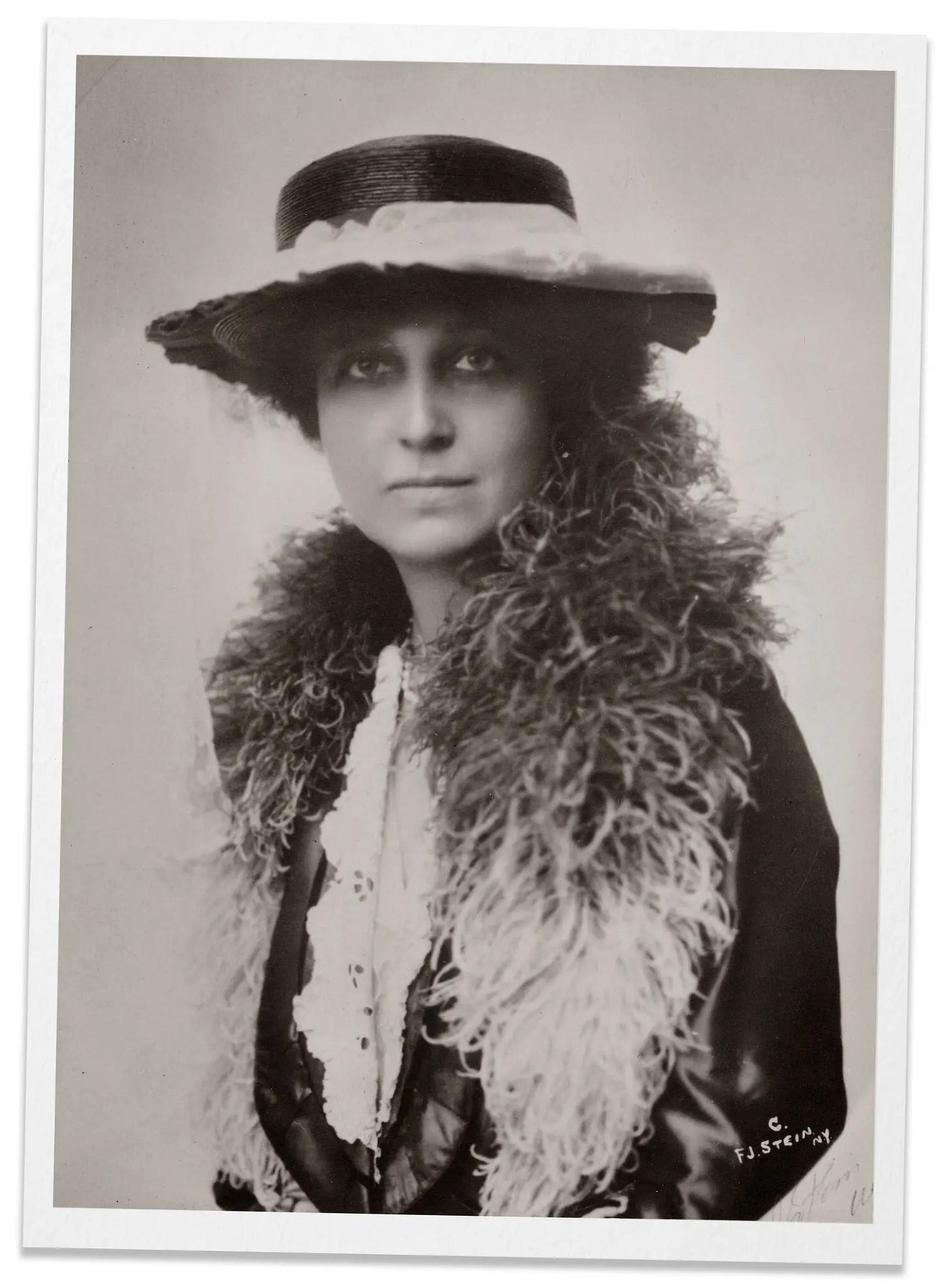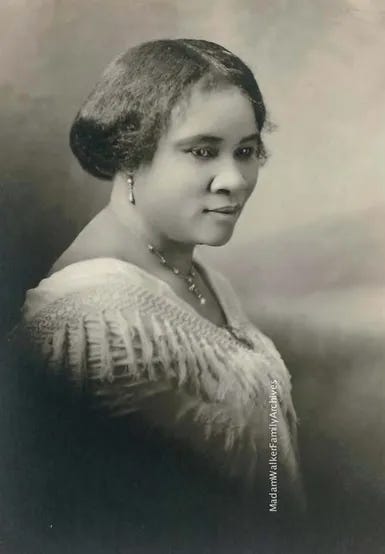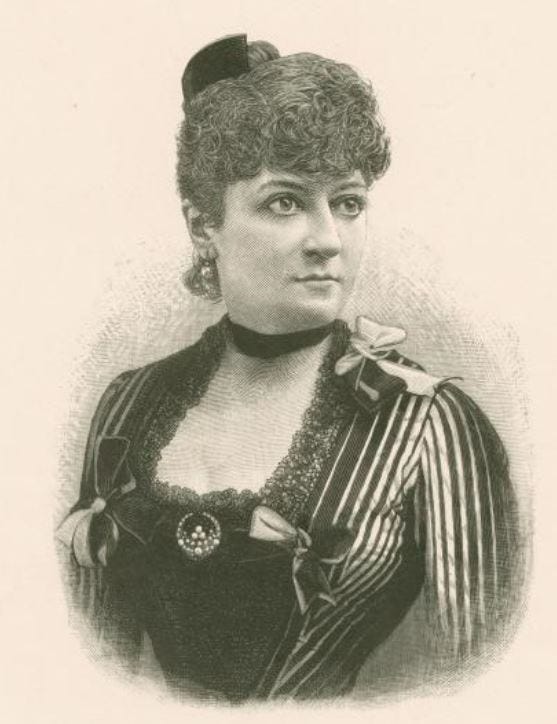Money talks and no one knows it like these nineteenth century women who used their insane fortunes to improve women’s lives. They did it by funding the pill and insisting medial schools admit women. They did it by supporting Black culture and working women on strike. They did it by funding the most audacious Suffs and their stunts to help get women the vote. Here are their (brief) stories:
Katharine Dexter McCormick paid for the pill
Had the customs official in New York in 1923 stopped to look closely at the luggage—all eight steamer trunks—of the society woman standing before him, he would have found something very interesting, even illegal. But no, she was the famous heiress Katharine McCormick so he let her go. Inside all her trunks were coats and dresses, the height of Paris fashion. Inside all those coats and dresses, carefully sewn between the lining, were diaphragms.
Birth control was still illegal but women like Katharine and her friend Margaret Sanger saw that it was essential for women’s dignity, freedom and full equality. At first, McCormick did her part for the cause by smuggling birth control from Europe for Sanger’s clinics to distribute. She also funded Sangers tours, work and organization (it would eventually be known as Planned Parenthood). But there was never enough supply for the demand for birth control and methods like diaphragms were clumsy and hard to use.
If only there was a magic pill! But no governments or pharmaceutical companies wanted to fund the necessary research. Dr. Gregory Goodwin Pincus, a rogue scientist, was was conducting research that would lead to the pill. McCormick, who wasn’t just a socialite but also an MIT graduate, evaluated the research and determined in was worth funding. She certainly had the money. At this point, McCormick was in her 70s, and her husband died leaving her a fortune that would be worth hundreds of millions in today’s dollars. She ended up spending about twenty million (today’s amount) to fund the development of the pill (which has a complicated and not always great history). As Jonathan Eig writes in his book The Birth of the Pill, “If it had not been for the persistence and extraordinary beneficence of Katharine McCormick, the birth control project might have gone nowhere.” We needed a woman with money to make it happen.
Alva Belmont supported the Suffs and lady strikers
Before she was Alva Belmont, she was Alva Vanderbilt. She was best known as the new money upstart rival to the Mrs. Caroline Astor and spent years and millions in a battle for control of New York Society. She even went as far as to force her daughter, Conseulo, to marry the Duke of Marlborough, even though her daughter was in love with someone else. Alva craved the prestige of a duke in the family, especially after scandalizing society with her divorce from her husband for his philandering. Her life is an inspiration for plot points on the show Gilded Age.
She next married longtime friend Oliver Belmont. After he died in 1908, Alva was single with the fortunes of two wealthy husbands. She started spending it on women’s suffrage and women’s rights. In New York City, she funded the first “Suffrage Settlement House” in Harlem and worked with leading Black clubwomen to form a branch of her Political Equality League.
Alva also opened suffrage cafés, where working folks could come for a hot meal for just twenty-five cents, served on plates declaring “votes for women!” When women garment workers went on strike for better wages and working conditions, Alva was there to support them. When the strikers were arrested and assaulted on the picket line, Alva went downtown to bail them out of jail. She opened up Marble House, her fabulous Newport Mansion, to suffrage fundraising events.
She also bankrolled Alice Paul and the work of her National Women’s Party. It was Alva’s money that paid for the offices—now known as the Belmont Sewell House. Her financial support made possible the huge parades, Silent Sentinels and Alice Paul’s other radical, militant stunts that helped get suffrage over the line. Alva could be bossy, demanding and her financial gifts certainly came with strings, but her money proved to be invaluable for the cause. We needed a woman with money to support women fighting for causes they cared about.
Madame CJ Walker supported Black culture and arts
Madame CJ Walker made her fortune by creating haircare products for Black women. She started selling them door to door before expanding to a mail order business. She also started a program called the “Walker System” which was a national network of agents who sold her products and earned commission on it, which not only grew her business but also helped her fellow Black women obtain financial independence—as many as several thousand. The full story of her life and business is worth a look (check out the Netflix show Self Made: Inspired by the Life of Madame C.J. Walker).
Suffice it to say, she earned a fortune and she didn’t just keep it to herself. She generously supported education for Black women and girls, and the National Association of Colored Women’s Clubs. She hired the first licensed Black architect to build a mansion in Irvington-on-Hudson in New York, and this grand home became the gathering place for Black community leaders. Her daughter, A'Lelia Walker hosted salons in her Harlem Townhouse and it became the epicenter of the Harlem Renaissance and a safe space for artists and queer folks to gather. Through the causes she supported and the spaces she and her daughter created, they were able to give back to the Black community.
Mary Elizabeth Garrett’s gift opened doors for women in medicine
In the 1880s, Mary Elizabeth and her fabulously wealthy besties gathered every other Friday night for intellectual conversation. They called themselves “The Friday Evening Group” and they didn’t just chat—they got things done. Their fathers were all on the board of John Hopkin’s University and through them, the women learned that the university needed five hundred thousand dollars to establish their medical school. This sparked an idea: they would raise the money and stipulate that the medical school had to accept women. This was literally the only way women were going to get into medical school in America—not because they didn’t qualify—but because men didn’t want to let them in.
This didn’t come from nowhere—women had been pushing their way into medicine ever since Elizabeth Blackwell became the first women to graduate from medical school in 1849. Since then, women had tried forming their own medical schools (with some success) and tried to gain acceptance to established (male only) schools like Harvard. A brilliant European-educated lady doctor like Mary Putnam Jacobi could win Harvard’s top for a scientific essay (proving that menstruation was not incapacitating for women), but could not enroll.
The Friday Evening Ladies decided to do something. With their society connections and networks, they were able to raise money and garner the attention of the press. Very quickly, they obtained the first hundred thousand dollars. Time passed. There was a lot of back and forth. Eventually, Mary Elizabeth said enough! She herself would fund the outstanding amount—over three hundred thousand dollars. Not only did she stipulate that women must be allowed admittance, but the school would also have incredibly strict entrance requirements.
When the John Hopkins Medical School opened in 1893, there were three women in its class. It took an heiress with an agenda to secure their spot, which helped normalize women in higher education. Now women are over 50% of first year medical school students.
Mrs. Frank Leslie’s surprise bequest changed the game for suffrage
In 1914, the executives at the National American Women’s Suffrage Association received some shocking news: they would receive the astronomical sum of nearly two million dollars from the estate of Mrs. Frank Leslie, publishing tycoon. They had never before received a gift this large—and from a woman, too!
She was born Miriam Folline in New Orleans in 1836 to a family without wealth or distinction. She made her way to New York City and remade herself there in one of the few ways available to women: marriage. Her first was annulled after two years. Her second marriage ended in divorce so she could marry Frank Leslie, the newspaper publisher. She had been writing and editing for one of his publications. Romance then marriage ensued. Long story short he died, she changed her name to his (Mrs. Frank) and took over his publishing empire and made it her own—and incredibly successful. Her life story is wild.
Mrs. Frank had been consistently supporting suffrage with small gifts over the years, but this massive bequest was a surprise. It was fought over in the courts, but in the end Carrie Chapman Catt got control of it in 1917 and used it to fund the Leslie Woman Suffrage Commission, which was a 25 person press bureau to educate the public on women’s suffrage. They compiled statistics, made pamphlets, answered questions, replied to articles in the press, concocted replies to Anti-Suffs. This work undoubtedly helped turned the tide of public opinion in favor of women’s suffrage.
***
Some of these fortunes where inherited, some were hard-won through divorce or received after death, some were self-made. We can draw a straight line back to Elizabeth Cady Stanton and Susan B. Anthony in 1854, campaigning to change the laws so that married women could own property, have their own damn money and decide what to do with it. Generations of Suffs fought so widows wouldn’t be left destitute—and fortunes would go to surviving wives instead of the next male relative by default. They worked hard to change laws, culture and society so that there would be life for a woman after the end of a marriage. The list could go on, but the groundwork was laid by earlier generations for these women to be able to wield their fortunes in favor of women.
Had they not, these fortunes used to fuel the women’s right movement might have just gone to men to, I dunno, wager on sports or try to go to Mars.
In the middle of working on this piece I saw a Threads post that struck a chord: “Women billionaires existing isn’t the win for feminism you think it is.” In this new gilded age we’re in, it’s hard to argue in favor of just a few people with massive fortunes at their disposal to determine how the rest of us live. A better feminism might be true community wealth and community decision making.
But I want women to have their own money, under their own control, no matter the amount. I’m grateful these women used their fortunes as they did. To me, these stories show the importance not just of women having wealth at their disposal, but of women being listened to and women having the freedom to make decisions. Because often, women will consider women’s issues, which have been so often overlooked or deemed unimportant by establishment men.
Study after study has shown that when women have control over the money in the household, they spend it on food, supporting children, and education—things that help families prosper and succeed. That is a win for feminism. For all of us.
But I also believe that women won’t “win” by a few people of any gender of hoarding wealth. Not even Lady Billionaires are the answer. It’s the distribution of it that has the power to propel us all forward and generate more.









What great stories. And such inspiration. I just recently learned that Katharine McCormick was also the person who made MIT back down from their mandate that women students always wear hats in MIT labs. She argued that it was a fire hazard, apparently, after having lost some pricey millinery to a Bunsen burner! As always, Maya, thank you so much. I wish you could put these sorts of posts on a video loop and play them in every grade school in America.